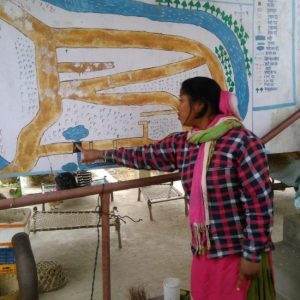After four years as a member of the Zurich Climate Resilience Alliance (“the Alliance”), I had the opportunity to catch a glimpse of our work in West Nepal. Practical Action and our local partner, CSDR, have been working for 5 years to support communities to become more resilient to the river Karnali’s floods.
Improving flood resilience is a multi-faceted objective, which involves making the link between development and disaster risk reduction. The definition of flood resilience used by the Alliance recognizes this transversality: resilience is “the ability of a system, community or society to pursue its social, ecological and economic development objectives, while managing its disaster risk over time in a mutually reinforcing way” (Keating et al., 2017).
To grasp better the variety of issues that flood resilience embraces, the Alliance has developed a conceptual framework called the 5C-4R: 5 “Capitals” (Human, Social, Physical, Natural and Financial) and 4 “R” (Robustness, Redundancy, Resourcefulness and Rapidity), based on the Sustainable Livelihoods Approach (SLA) that was adopted by the UK’s DFID and the properties of a resilient system developed at MCEER at the University of Buffalo.
 After a one-hour flight from Kathmandu, a three hours’ drive and a delicious Nepalese Thali Set, a dish that accompanied me all along my time in Nepal, I started a three days visit to flood-prone communities where we implemented interventions to strengthen their resilience to floods. The field visit gave me an outlook of concrete actions related to some of the flood resilience properties described in the 5C-4R framework:
After a one-hour flight from Kathmandu, a three hours’ drive and a delicious Nepalese Thali Set, a dish that accompanied me all along my time in Nepal, I started a three days visit to flood-prone communities where we implemented interventions to strengthen their resilience to floods. The field visit gave me an outlook of concrete actions related to some of the flood resilience properties described in the 5C-4R framework:
– Banana is a crop that resist to minor floods and as such, is an example of increasing Robustness to withstand floods. Training 25 farmers, who then get organized to sell their banana products together, is a good example of improved Human and Social capital. Learn more about banana farming in flood deposited sandy oil in our Technical Brief.
– Community shelters give villagers a Rapid way to safeguard goods and assets in case of floods, increasing thus the Physical capital of households. When there is no floods, these shelters are used for other tasks such as community meetings, adult education, and vegetablecollection center. As such, there are an example of Resourcefulness, and a mean to strengthen Human and Social Capital.
– When poor farmers with reduced lands are trained to grow mushroom in small huts, they improve their Financial capital, as they generate extra resources that can help them to cope with negative impacts of floods. They also improve their Redundancy, as they do no longer depend on a single source of income (for more information on Indoor Oyster Mushroom farming, you can download this Technical brief).
After meeting such resilient people in Lower Karnali came the time to go back to the capital. But I would not leave without eating a last Nepalese Thali Set. And I started thinking on what the communities I met have in common with this delightful Nepalese dish. I realized that they share similar resilience properties: Nepalese Thali Sets are usually served Rapidly, they provide different types of calories to make Redundancy a reality while the limitless refills definitely make you Robust. And Thalis always managed to balance flavours in a very resourceful way!